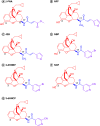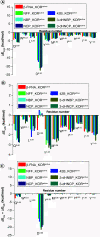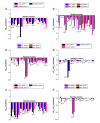Exploring the putative mechanism of allosteric modulations by mixed-action kappa/mu opioid receptor bitopic modulators
- PMID: 33590767
- PMCID: PMC8027703
- DOI: 10.4155/fmc-2020-0308
Exploring the putative mechanism of allosteric modulations by mixed-action kappa/mu opioid receptor bitopic modulators
Abstract
The modulation and selectivity mechanisms of seven mixed-action kappa opioid receptor (KOR)/mu opioid receptor (MOR) bitopic modulators were explored. Molecular modeling results indicated that the 'message' moiety of seven bitopic modulators shared the same binding mode with the orthosteric site of the KOR and MOR, whereas the 'address' moiety bound with different subdomains of the allosteric site of the KOR and MOR. The 'address' moiety of seven bitopic modulators bound to different subdomains of the allosteric site of the KOR and MOR may exhibit distinguishable allosteric modulations to the binding affinity and/or efficacy of the 'message' moiety. Moreover, the 3-hydroxy group on the phenolic moiety of the seven bitopic modulators induced selectivity to the KOR over the MOR.
Keywords: allosteric modulation mechanism; kappa opioid receptor (KOR)/mu opioid receptor (MOR); mixed-action KOR/MOR ligand; molecular dynamics simulations; psychostimulant abuse and addiction; selectivity.
Conflict of interest statement
This work was partially supported by the Virginia Commonwealth University Center for High-Performance Computing and NIH/National Institute on Drug Abuse grants R01DA024022, R01DA044855 and UG3DA050311 (Y Zhang) and R01 DA041359, R21 DA045274 and P30 DA013429 (L-Y Liu-Chen). The authors have no other relevant affiliations or financial involvement with any organization or entity with a financial interest in or financial conflict with the subject matter or materials discussed in the manuscript apart from those disclosed.
No writing assistance was utilized in the production of this manuscript.
Figures






Similar articles
-
Computational insights into the molecular mechanisms of differentiated allosteric modulation at the mu opioid receptor by structurally similar bitopic modulators.J Comput Aided Mol Des. 2020 Aug;34(8):879-895. doi: 10.1007/s10822-020-00309-x. Epub 2020 Mar 19. J Comput Aided Mol Des. 2020. PMID: 32193867
-
Design, synthesis, and biological evaluation of 14-heteroaromatic-substituted naltrexone derivatives: pharmacological profile switch from mu opioid receptor selectivity to mu/kappa opioid receptor dual selectivity.J Med Chem. 2013 Nov 27;56(22):9156-69. doi: 10.1021/jm4012214. Epub 2013 Nov 7. J Med Chem. 2013. PMID: 24144240 Free PMC article.
-
Controlling opioid receptor functional selectivity by targeting distinct subpockets of the orthosteric site.Elife. 2021 Feb 8;10:e56519. doi: 10.7554/eLife.56519. Elife. 2021. PMID: 33555255 Free PMC article.
-
Development of Diphenethylamines as Selective Kappa Opioid Receptor Ligands and Their Pharmacological Activities.Molecules. 2020 Nov 2;25(21):5092. doi: 10.3390/molecules25215092. Molecules. 2020. PMID: 33147885 Free PMC article. Review.
-
Potential for Kappa-Opioid Receptor Agonists to Engineer Nonaddictive Analgesics: A Narrative Review.Anesth Analg. 2021 Feb 1;132(2):406-419. doi: 10.1213/ANE.0000000000005309. Anesth Analg. 2021. PMID: 33332902 Free PMC article. Review.
Cited by
-
Structural Characterization of KOR Inactive and Active States for 3D Pharmacology and Drug Discovery.Handb Exp Pharmacol. 2022;271:41-64. doi: 10.1007/164_2021_461. Handb Exp Pharmacol. 2022. PMID: 33945028 Review.
-
NCP, a Dual Kappa and Mu Opioid Receptor Agonist, Is a Potent Analgesic Against Inflammatory Pain without Reinforcing or Aversive Properties.J Pharmacol Exp Ther. 2024 Mar 15;389(1):106-117. doi: 10.1124/jpet.123.001870. J Pharmacol Exp Ther. 2024. PMID: 38409113 Free PMC article.
-
Biased, Bitopic, Opioid-Adrenergic Tethered Compounds May Improve Specificity, Lower Dosage and Enhance Agonist or Antagonist Function with Reduced Risk of Tolerance and Addiction.Pharmaceuticals (Basel). 2022 Feb 10;15(2):214. doi: 10.3390/ph15020214. Pharmaceuticals (Basel). 2022. PMID: 35215326 Free PMC article. Review.
-
Systematic Structure-Activity Relationship Study of Nalfurafine Analogues toward Development of Potentially Nonaddictive Pain Management Treatments.J Med Chem. 2024 Jun 13;67(11):9552-9574. doi: 10.1021/acs.jmedchem.4c00646. Epub 2024 May 30. J Med Chem. 2024. PMID: 38814086 Free PMC article.
References
-
- Substance Abuse and Mental Health Services Administration. www.samhsa.gov/data/
-
- White FJ, Kalivas PW. Neuroadaptations involved in amphetamine and cocaine addiction. Drug Alcohol Depend. 51(1–2), 141–153 (1998). - PubMed
-
- Lott DC, Lott DC, Kim S-J et al. Serotonin transporter genotype and acute subjective response to amphetamine. Am. J. Addict. 15(5), 327–335 (2006). - PubMed
-
- Broadbear JH, Sumpter TL, Burke TF et al. Methocinnamox is a potent, long-lasting, and selective antagonist of morphine-mediated antinociception in the mouse: comparison with clocinnamox, β-funaltrexamine, and β-chlornaltrexamine. J. Pharmacol. Exp. Ther. 294(3), 933–940 (2000). - PubMed
-
- American Addiction Centers. https://americanaddictioncenters.org/stimulant-drugs
Publication types
MeSH terms
Substances
Grants and funding
LinkOut - more resources
Full Text Sources
Other Literature Sources
Research Materials
